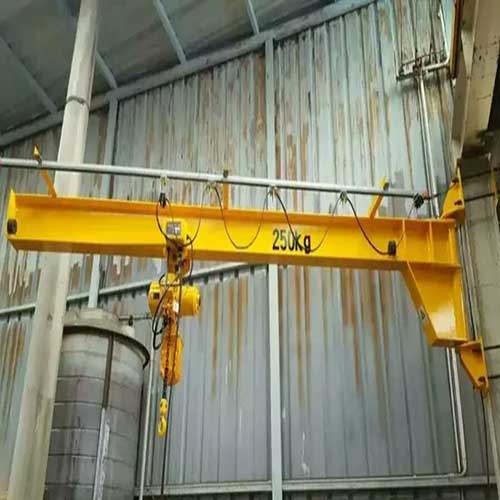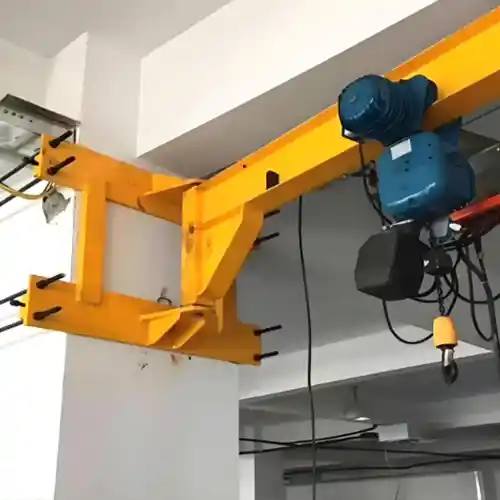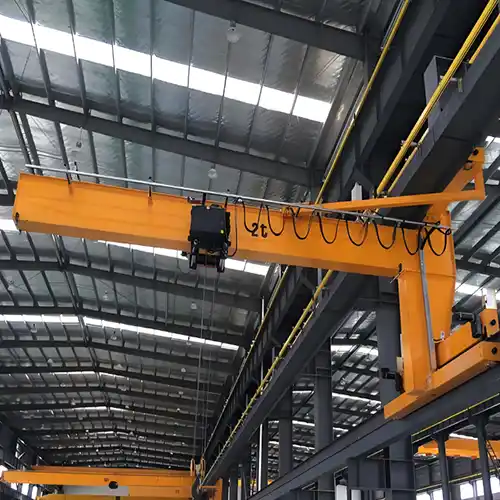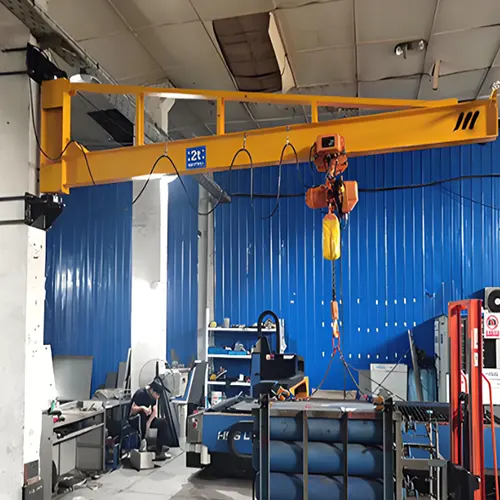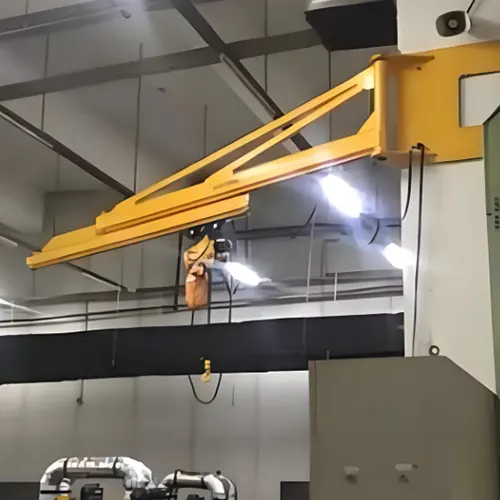Wall Jib Crane for Sale, 1 Ton 2 Ton 3 Ton Wall Jib Crane System
Wall jib crane for sale. Custom wall jib crane system, wall mounted & wall travelling jib, with cantilever, tie rod, articulating jib arm design for you.
| Crane type | Wall jib crane |
| Specifications | 250kg, 500kg, 1 ton, 2 ton, 3 ton, 5 ton |
| Jib arm | Customized as your request |
Category: Wall Crane
Your Trusted Wall Jib Crane Manufacturer & Supplier
Wall Jib Crane for Sale 1 Ton 2 Ton 3 Ton
Wall Mounted & Wall Travelling Jib, with Cantilever, Tie Rod, Articulating Jib Arm Design
Wall jib crane for sale. Custom wall jib crane system, wall mounted & wall travelling jib, with cantilever, tie rod, articulating jib arm design for you.
Title: Comprehensive Guide to wall jib cranes
Wall jib cranes, often regarded as the stalwarts of vertical lifting solutions, are purpose-built mechanical devices ingeniously designed to streamline material handling within confined spaces. These cranes, distinctively mounted on vertical surfaces, feature a versatile jib arm that can pivot, extend, and rotate. This arrangement facilitates the seamless movement of loads, optimizing both spatial constraints and operational workflows.
At its core, the wall jib crane comprises a pivotal mechanism allowing the jib arm's lateral movement, augmented by a robust hoisting apparatus. This amalgamation of engineering prowess empowers the crane to perform tasks ranging from precision load positioning to the transfer of heavy components, all while conserving valuable floor area.
Importance of wall jib cranes in Material Handling:
The pivotal role of wall jib cranes in material handling cannot be overstated. They serve as an embodiment of operational efficiency and safety, offering a multitude of benefits that redefine workspace dynamics:
- Space Liberation and Utilization: wall jib cranes expertly exploit vertical real estate, unlocking untapped space potential that traditional floor-bound cranes cannot. This spatial ingenuity translates to enhanced operational fluidity and streamlined movement.
- Pinpoint Accuracy: The hallmark feature of wall jib cranes is their ability to position loads with remarkable precision. This attribute becomes paramount in industries where intricate alignments and meticulous placements are essential, ultimately bolstering productivity and quality.
- Workplace Safety: By shouldering the burden of heavy lifting, wall jib cranes alleviate the physical strain on workers, reducing the likelihood of injuries caused by manual handling. This safety enhancement contributes to a secure and employee-centric work environment.
- Versatility Redefined: From micro-components to substantial loads, wall jib cranes flexibly accommodate a spectrum of materials. This adaptability makes them indispensable across diverse sectors, from manufacturing plants to distribution hubs.
- Operational Fluidity: The integration of wall jib cranes in material handling processes translates to a seamless workflow. Tasks like loading and unloading machinery, transferring goods between stations, and optimizing assembly line processes become both efficient and effortless.
- Economic Advantages: Beyond their operational prowess, wall jib cranes wield economic advantages. By streamlining processes, reducing downtimes, and curbing potential damages, they contribute to a healthier bottom line.
As we embark on this exploration into the realm of wall jib cranes, the subsequent chapters will delve into the technical intricacies, diverse types, optimal design considerations, operational finesse, maintenance essentials, and the potential returns on investment. With every page turned, we unravel the mechanics that underpin these dynamic solutions and the transformative impact they have on modern material handling practices.
Basics of wall jib cranes
Welcome to the foundation of our journey into the world of material handling excellence. In this inaugural chapter, we lay the groundwork for understanding the intricacies of wall jib cranes—remarkable devices that have revolutionized how we handle materials within constrained spaces. Let's delve into the essential elements that make these cranes an indispensable asset in modern industries.
Explanation of wall jib crane Terminology
In the expansive realm of material handling, precision in language is paramount. This section serves as a compass to navigate through the lexicon of wall jib cranes, illuminating the terms that are the cornerstones of comprehension.
- Jib Crane: Imagine the heart of the crane—the jib arm. It's the horizontal extension that possesses the magical ability to rotate, enabling the crane to cover a predefined area without having to reposition the entire structure.
- Wall Jib Crane: Allow us to introduce you to the star of our show—the wall-mounted jib crane. Designed to cling to vertical surfaces like walls and columns, this ingenious engineering marvel optimizes space while enhancing lifting capabilities.
- Rotation: This term embodies the pivotal movement of the jib arm around a fixed point. Think of it as the crane's dance partner, twirling elegantly to place loads with utmost precision.
- Load Capacity: The anchor of safety and efficiency. Load capacity represents the maximum weight a wall jib crane can gracefully handle. It's the golden rule that guides the selection of the right crane for the task at hand.
Components of a wall jib crane
Imagine a symphony of mechanics working harmoniously to lift, move, and position loads. This section peels back the curtain to unveil the intricate components that compose the symphony of a wall jib crane.
- Boom (Jib Arm): Visualize the arm that extends horizontally from the crane's pivot point—it's the boom. The magician's wand of the crane world, the boom orchestrates load movement with finesse.
- Pivot Mechanism: Like the axis of a planet, the pivot mechanism serves as the crane's center of rotation. It's the mechanism that brings life to the crane's graceful movements.
- Mounting Structure: Picture the crane's anchor—its mounting structure. This element secures the crane to the wall or column. Options abound, from direct wall attachment to bracket-supported ingenuity.
- Hoist Mechanism: Meet the powerhouse— the hoist mechanism. Responsible for the vertical dance of lifting and lowering, the hoist mechanism embodies the crane's capability to elevate loads with ease.
Main Types of Wall Jib Cranes

Features:
- Fixed wall or column attachment.
- Up to 180-degree rotation.
- Compact design for confined spaces.
- Various load capacity options.
- Optimizes space, ideal for small areas.
- Precise load positioning.
- Reduces floor obstruction.
- Versatile for manufacturing and warehouses.
- Manufacturing workstations.
- Warehousing for loading/unloading.
- Maintenance tasks.
- Small-scale operations.

Features:
- Horizontal rail for movement.
- Combines rotation and travel.
- Extended coverage with rail.
- Accurate load positioning.
- Versatile for both horizontal and vertical movement.
- Covers a wider area efficiently.
- Enhances assembly line productivity.
- Ideal for precise loading/unloading.
- Optimizes space usage.
- Manufacturing and assembly lines.
- Warehousing for extended storage.
- Construction sites with complex layouts.
- Workshops for repairs and maintenance.

Fixed Wall Jib Crane:
Features:
- Fixed position on the wall or vertical surface.
- Fixed jib arm that can rotate horizontally.
- Typically available in various load capacity options.
- Suitable for precise load positioning within a limited area.
- Maximizes use of vertical space while minimizing floor obstruction.
- Provides precise load positioning without moving the entire crane.
- Cost-effective and straightforward design.
- Enhanced safety due to reduced risk of collisions in crowded work areas.
- Manufacturing: For moving and positioning materials in production cells.
- Workshops: For tasks such as engine or equipment maintenance.
- Loading docks: For loading and unloading of goods from trucks.
- Assembly lines: For precise part placement during assembly processes.

Articulating Wall Jib Crane:
Features:
- Multi-segmented jib arm with articulating joints.
- Offers greater flexibility and reach around obstacles.
- Available in various load capacity options.
- Capable of precise load positioning.
- Versatile and adaptable for accessing tight or hard-to-reach spaces.
- Reduces the need for extensive manual labor in complex work areas.
- Provides precise control over load placement.
- Suitable for handling irregularly shaped or oversized loads.
- Manufacturing: For reaching into workstations with obstacles.
- Warehouses: For retrieving items from high shelves or racks.
- Construction sites: For lifting materials in confined spaces.
- Assembly lines: For positioning components during assembly.

Telescoping Wall Jib Crane:
Features:
- Jib arm with telescoping sections that extend and retract.
- Variable reach capabilities.
- Available in various load capacity options.
- Precise load positioning.
- Adjustable reach for handling loads at varying distances.
- Efficient use of space, as it can reach both near and far areas.
- Reduces the need for multiple cranes with fixed jib arms.
- Ideal for tasks with changing load placement requirements.
- Warehouses: For accessing goods on different shelves or racks.
- Loading docks: For reaching into trucks with varying load positions.
- Assembly lines: For accommodating changing assembly processes.
- Manufacturing: For handling materials with variable placement needs.

Foundation-Mounted Wall Jib Crane:
Features:
- Designed to be attached to a foundation or floor.
- Offers similar functionality to wall-mounted cranes.
- Available in various load capacity options.
- Precise load positioning.
- Suitable for situations where wall mounting is not feasible.
- Provides stability and support for heavy loads.
- Maximizes vertical space utilization.
- Enhances safety in areas with floor space limitations.
- Heavy manufacturing: For lifting and positioning large machinery.
- Construction sites: For material handling in outdoor environments.
- Warehouses: For efficiently accessing goods in storage.

Features:
- Compact design for limited vertical clearance.
- Short jib arm suitable for low headroom environments.
- Horizontal rotation for precise load positioning.
- Maximizes vertical space in areas with low headroom.
- Efficient use of floor space while providing lifting capabilities.
- Enhanced safety by reducing overhead collision risks.
- Workshops, garages, and machine shops.
- Retail spaces and stock handling.
- Industrial maintenance areas.
- Assembly lines with limited vertical space.

Explosion-Proof Wall Jib Crane:
Features:
- Specially designed for hazardous environments.
- Sealed electrical components and protected electronics.
- Compliance with strict safety standards.
- Safe operation in explosive atmospheres.
- Reduced risk of sparks or heat causing explosions.
- Precision load handling and compliance assurance.
- Chemical plants and oil refineries.
- Pharmaceutical manufacturing.
- Grain handling facilities.
- Paint and coating operations.

Corrosion-Resistant Wall Jib Crane:
Features:
- Extended lifespan, reducing maintenance costs.
- Reliable performance in corrosive conditions.
- Cost-efficiency over time.
- Ideal for marine, chemical, and wastewater industries.
Typical Applications:
- Marine and offshore environments.
- Chemical processing plants.
- Wastewater treatment facilities.
- Food processing and outdoor use.
Each type of wall jib crane has its own set of features that make it suitable for particular applications. Choosing the right type depends on factors such as available space, load capacity, reach requirements, and the need for precise load positioning. These cranes play a crucial role in improving material handling efficiency and safety across various industries.

Customized Wall Jib Crane:
Features:
- Tailored to meet specific application requirements.
- Customizable load capacity, jib arm length, and features.
- Precise load positioning.
- Addresses unique operational needs and challenges.
- Optimizes crane performance for specific tasks.
- Maximizes efficiency and safety for specialized applications.
- Any industry or setting where standard cranes do not fully meet requirements.
- Specialized manufacturing processes.
- Unique lifting or positioning challenges.
Types of Loads Handled by wall jib cranes
Material handling is an art form, and wall jib cranes are its virtuosos. This section provides a glimpse into the diverse range of loads these cranes have been designed to maneuver.
- Raw Materials: Imagine the crane as the conductor of a symphony—guiding raw materials seamlessly to manufacturing stations, amplifying production efficiency.
- Finished Products: The story doesn't end with manufacturing. wall jib cranes step into the spotlight, orchestrating the movement of finished goods—making distribution and storage a harmonious endeavor.
- Heavy Components: Witness the crane's might as it gracefully lifts and places hefty components—machinery parts, equipment— with the finesse of an artist at work.
- Precision Tasks: Delicate as a ballet dancer, the crane shines in precision tasks. Whether it's placing fragile items or aligning intricate components, precision is the crane's forte.
- Bulk Materials: Think of the crane as a conveyor of efficiency in bulk industries. wall jib cranes elegantly handle bulk materials, simplifying the transfer of goods in sectors like construction and agriculture.
As this inaugural chapter draws to a close, we've uncovered the ABCs of wall jib cranes—terminology, components, and load handling capabilities. Just as a masterpiece is painted layer by layer, our journey into the intricacies of these dynamic material handling solutions will continue with each subsequent chapter. Brace yourself for an enlightening exploration into the heart of wall jib cranes.
Advantages and Applications
As we venture deeper into the realm of wall jib cranes, the second chapter unveils a tapestry woven with advantages and applications that illuminate the significance of these ingenious material handling solutions. Brace yourself for a journey that will highlight the strengths of wall jib cranes and unveil the multitude of industries and scenarios where their prowess shines.
Advantages of wall jib cranes
In the dynamic landscape of material handling, wall jib cranes stand as unsung heroes, each feature contributing to enhanced efficiency and precision. This section celebrates the numerous advantages that make these cranes a cornerstone of modern operations.
- Space Efficiency: Dive into how wall jib cranes revolutionize spatial utilization. Their vertical mountings optimize floor space, enabling operations within tight confines that traditional cranes cannot match.
- Load Positioning Precision: Precision is the hallmark of success. Explore how wall jib cranes offer unparalleled accuracy in load placement, reducing the risk of damages and streamlining tasks that demand pinpoint positioning.
- Versatility Redefined: Witness the inherent flexibility of wall jib cranes. Delve into their capacity to handle diverse loads, from fragile components to robust machinery, adapting seamlessly to varying operational needs.
Industries and Applications
In a world where versatility reigns supreme, wall jib cranes find their niche across industries and applications. This section showcases their versatility by diving into the diverse sectors that benefit from their capabilities.
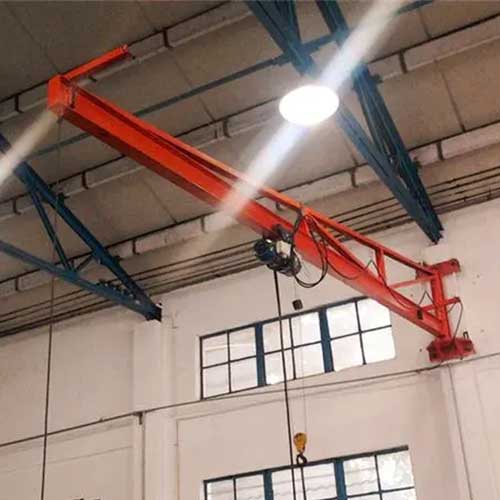
1. **Manufacturing and Assembly:
Wall jib cranes are commonly used in manufacturing facilities to assist in lifting and positioning heavy components during assembly processes. They improve efficiency and reduce the physical strain on workers.
- Description: Wall-mounted jib cranes with 180-degree rotation.
- Features: Precision control, compact design.
- Benefits: Efficient component positioning, reduced worker fatigue.
- Typical Applications: Assembly lines, workstations.
- Customized Features: Load capacity, rotation angle.
2. **Warehousing and Material Handling:
In warehouses, these cranes are employed for tasks such as loading and unloading goods from shelves, racks, or pallets. They enhance material handling efficiency and optimize storage space.
- Description: Wall jib cranes with extended reach.
- Features: Horizontal rail, precise load positioning.
- Benefits: Maximizes vertical storage, faster material handling.
- Typical Applications: Loading/unloading, inventory management.
- Customized Features: Horizontal travel distance.
3. **Maintenance and Repair:
Wall jib cranes are valuable in maintenance areas for lifting machinery, equipment, and parts for inspection and repair. They provide precise control during these tasks.
- Description: Wall jib cranes with 180-degree rotation.
- Features: Accurate load control, compact footprint.
- Benefits: Safe equipment maintenance, reduced downtime.
- Typical Applications: Machinery repairs, maintenance tasks.
- Customized Features: Lifting attachments.
4. **Workshops:
In workshops, such as automotive repair shops or metal fabrication facilities, wall jib cranes are used for hoisting engines, tools, and heavy materials, facilitating repair and fabrication processes.
- Description: Wall jib cranes with 180-degree rotation.
- Features: Precise load positioning, compact design.
- Benefits: Eases heavy machinery handling, enhances workflow.
- Typical Applications: Engine repair, metal fabrication.
- Customized Features: Load capacity, jib length.
5. **Construction Sites:
On construction sites, wall jib cranes can assist in lifting heavy construction materials like steel beams, concrete blocks, and equipment. They are especially useful in tight spaces or areas with limited access.
- Description: Wall-mounted jib cranes for heavy lifting.
- Features: Robust construction, vertical and horizontal movement.
- Benefits: Safely lifts construction materials, aids in complex sites.
- Typical Applications: Lifting steel beams, concrete blocks.
- Customized Features: Load capacity, reach.
6. **Loading Docks:
At loading docks in logistics and distribution centers, wall jib cranes help load and unload trucks and containers efficiently. They can handle a variety of goods, from pallets to heavy machinery.
- Description: Wall jib cranes with horizontal rail.
- Features: Extended reach, precise positioning.
- Benefits: Efficient loading/unloading, reduced labor.
- Typical Applications: Cargo handling, logistics.
- Customized Features: Rail length, load capacity.
7. **Shipping and Receiving:
Wall jib cranes are employed in shipping and receiving areas of manufacturing facilities to move materials and products between production and storage areas or prepare them for shipping.
- Description: Wall jib cranes with 180-degree rotation.
- Features: Accurate load control, compact design.
- Benefits: Speeds up shipping processes, reduces handling errors.
- Typical Applications: Moving products between production and storage.
- Customized Features: Load capacity, rotation angle.
8. **Foundries and Metalworking:
Industries like foundries and metalworking often use wall jib cranes to lift and transport molten metal or heavy metal workpieces.
- Description: Heavy-duty wall jib cranes with high load capacity.
- Features: Durable construction, precise load control.
- Benefits: Handles heavy metal workpieces, enhances safety.
- Typical Applications: Handling molten metal, moving metal workpieces.
- Customized Features: Load capacity, special coatings.
9. **Agriculture:
On farms and agricultural facilities, these cranes are used for tasks such as lifting and moving heavy bales of hay, machinery, and other agricultural equipment.
- Description: Wall jib cranes for agricultural tasks.
- Features: Compact design, precise control.
- Benefits: Efficient handling of hay bales, machinery.
- Typical Applications: Lifting and moving agricultural equipment.
- Customized Features: Load attachments, jib length.
10. **Retail and Commercial Spaces:
In retail and commercial settings, wall jib cranes can be utilized for various purposes, including lifting and positioning merchandise, signage, or decorations.
- Description: Wall jib cranes for commercial use.
- Features: Compact design, precise load control.
- Benefits: Versatile positioning of merchandise, decorations.
- Typical Applications: Retail displays, signage installation.
- Customized Features: Load attachments, aesthetics.
11. **Waste Management:
Wall jib cranes assist in handling waste materials in recycling centers or waste management facilities, making the process more efficient and reducing the risk of worker injuries.
- Description: Wall jib cranes for waste handling.
- Features: Robust construction, precise load control.
- Benefits: Efficient waste material handling, reduces worker strain.
- Typical Applications: Handling recyclables, waste management.
- Customized Features: Load capacity, waste-specific attachments.
12. **Food Processing:
In food processing plants, wall jib cranes are used for lifting and positioning heavy equipment and materials used in food production and packaging.
- Description: Hygienic wall jib cranes for food industry.
- Features: Stainless steel construction, precise load control.
- Benefits: Safe food equipment handling, meets sanitation standards.
- Typical Applications: Lifting food processing equipment.
- Customized Features: Food-grade materials, load attachments.
These descriptions provide an overview of the types of wall jib cranes commonly used in various industrial sectors, highlighting their features, benefits, typical applications, and any customization specific to each industry's needs.
As this chapter unfolds, the advantages of wall jib cranes will come to life, and their adaptability across various industries and scenarios will become evident. From production floors to warehouses, workshops to construction sites, the ubiquity of these cranes is a testament to their indispensable role in modern material handling. Prepare to be immersed in a world where efficiency, precision, and versatility converge.
Design and Configuration
Embarking on the intricacies of wall jib crane design and configuration, this chapter unravels the artistry that goes into crafting these remarkable material handling solutions. Join us as we delve into the factors that shape design decisions, the calculus of load capacity and working radius, and the meticulous material selection that underpins crane components.
Factors to Consider in wall jib crane Design
Design is a symphony of engineering and creativity. In this section, we explore the key factors that influence the design of wall jib cranes, setting the stage for a robust and functional outcome.
- Workspace Constraints: Unveil how the available workspace guides design choices. From determining the crane's size to selecting mounting options, workspace limitations define the crane's form.
- Load Characteristics: Understand how the nature of the load—its weight, shape, fragility—shapes the design. The crane must accommodate and handle the load with precision and safety.
- Operational Environment: Dive into the operational landscape. Considerations such as temperature, humidity, and exposure to corrosive elements impact the choice of materials and finishes.
- Safety Standards: Safety takes center stage. Delve into how adherence to industry standards influences design decisions, ensuring the crane operates within safety parameters.
Load Capacity and Working Radius Determination
Precision is key when calculating load capacity and working radius. This section unravels the calculations that dictate a crane's capabilities, ensuring optimal performance and safety.
- Load Capacity Calculation: Demystify the process of calculating the maximum weight a crane can handle. Explore the influence of factors like the boom's length, angle of operation, and crane design.
- Working Radius Definition: Understand how working radius defines the area the crane can cover. Delve into the interplay between working radius, jib arm length, and rotation capabilities.
- Load Chart Interpretation: Interpret the load chart—a map that guides crane usage. Discover how load charts depict permissible load capacities at various working radii and angles, aiding precise operation.
Material Selection for Crane Components
The building blocks of a crane lie in the materials chosen for its components. This section takes a closer look at material selection, a vital aspect that ensures durability and longevity.
- Boom and Components: Explore the choice of materials for the boom, pivot, mounting structure, and other key components. Different materials offer varying strength, corrosion resistance, and weight-bearing properties.
- Hoist Mechanism: Uncover the considerations behind selecting materials for the hoist mechanism. Balancing durability, weight, and load capacity plays a crucial role in this decision.
- Finishes and Coatings: Delve into the world of protective finishes and coatings. Understand how these treatments enhance component lifespan by guarding against corrosion and wear.
As this chapter unfolds, the intricate dance between design considerations, load capacity calculations, and material selections will be unveiled. Every aspect contributes to the harmonious performance of wall jib cranes, ensuring they not only meet but exceed the demands of modern material handling challenges. Prepare to journey through the meticulous process of crafting these dynamic solutions.
Installation and Mounting
In this chapter, we delve into the essential phase of bringing wall jib cranes to life—the installation and mounting process. From meticulous planning to choosing the right mounting option, and the careful execution of installation, we explore the intricate dance of turning concepts into tangible material handling solutions.
Pre-Installation Planning and Site Assessment
Before the crane takes its place, meticulous planning is a must. This section unveils the critical steps that lay the foundation for a successful installation.
- Site Assessment: Discover the importance of assessing the installation site. From space availability to structural integrity, understanding the environment sets the stage for seamless installation.
- Load Requirements: Dive into load considerations. Determining the types of loads and their expected frequency guides decisions on load capacity, crane type, and mounting options.
- Safety Precautions: Safety takes precedence. Explore the importance of identifying potential hazards and planning safety measures to ensure a secure installation process.
Mounting Options (Wall, Column, Structure)
- Mounting is the heart of a wall jib crane's stability. This section explores the various mounting options and their suitability for different scenarios.
- Wall Mounting: Uncover the intricacies of mounting directly to a wall. Delve into the structural requirements and the advantage of utilizing vertical surfaces for optimal space utilization.
- Column Mounting: Discover the flexibility of column mounting. Explore how columns can be strategically positioned to support the crane, enhancing stability and load capacity.
- Structure Mounting: Explore the world of mounting on existing structures. From beams to pillars, understand how utilizing existing structures can streamline the installation process.
Installation Process and Safety Considerations
The installation process marries precision with safety. This section takes you through the step-by-step journey of bringing a wall jib crane to life.
- Component Assembly: Witness the careful assembly of crane components. Learn how each part is meticulously integrated, ensuring functionality and stability.
- Mounting Execution: Delve into the mounting process, whether on walls, columns, or structures. Understand the importance of precise measurements and anchoring techniques.
- Wiring and Testing: Explore the final stages of installation, involving electrical wiring and testing of the crane's operational mechanisms. Safety protocols and functionality checks are paramount.
- Safety Protocols: Safety is non-negotiable. Learn about safety protocols that must be adhered to during installation, including proper equipment usage and personal protective measures.
As this chapter unfolds, you'll gain insights into the intricacies of turning plans into reality. From meticulous site assessment to the selection of mounting options and the careful execution of the installation process, every step is vital in ensuring a safe, efficient, and reliable wall jib crane. Prepare to witness the transformation from blueprints to fully functional material handling prowess.
Operation and Controls
In this chapter, we delve into the heart of the matter—operating a wall jib crane. From the fundamental principles of operation to the intricate controls that enable its maneuvers, join us on a journey through the art of guiding these dynamic material handling solutions.
Basic Operation of a wall jib crane
Understanding the fundamental operation of a wall jib crane is key. This section lays the groundwork for operating these cranes with finesse.
- Initial Setup: Explore the initial steps of preparing the crane for operation. This includes ensuring the crane is securely anchored, and all safety protocols are in place.
- Load Attachment: Learn the art of attaching loads to the hoist mechanism. Discover how to secure the load for safe lifting and movement.
- Jib Arm Movement: Dive into the control of the jib arm's movement. Understand how to rotate and extend the arm to position the load with precision.
Hoisting Mechanism and Controls
The hoisting mechanism is the lifeline of the crane. This section delves into the intricacies of the hoist and the controls that enable its vertical movement.
- Hoisting Basics: Uncover the principles behind the hoisting mechanism. Learn how the hoist motor and pulley system work together to lift and lower loads.
- Hoist Controls: Explore the control options for the hoisting mechanism. Understand how to operate the controls to ensure smooth and controlled vertical movement.
Rotational Movement and Slewing Controls
The ability to rotate the jib arm is crucial for reaching desired positions. This section unravels the mechanisms and controls behind rotational movement.
- Rotational Mechanism: Delve into the mechanics of the crane's rotational movement. Understand the role of the pivot point and the jib arm in achieving controlled rotation.
- Slewing Controls: Learn the art of controlling slewing or rotational movement. Discover how to guide the crane's rotation to place loads precisely where needed.
As this chapter unfolds, you'll gain insights into the intricate ballet of operating a wall jib crane. From understanding the basic principles to mastering the controls that govern its movement, you'll be equipped to navigate the crane's operation with confidence. Prepare to take the reins and guide these material handling solutions with finesse and precision.
Maintenance and Inspection
In this pivotal chapter, we delve into the realm of maintenance and inspection—an indispensable facet of keeping wall jib cranes operating at peak performance. From understanding the significance of regular maintenance to establishing inspection routines and troubleshooting, join us as we unveil the keys to ensuring the longevity and reliability of these dynamic material handling solutions.
Importance of Regular Maintenance
Maintenance is the lifeblood that sustains equipment. In this section, we explore why regular maintenance is paramount for the optimal performance and safety of wall jib cranes.
- Enhanced Reliability: Uncover how regular maintenance minimizes unexpected downtime by identifying and addressing potential issues before they escalate.
- Safety Assurance: Delve into how a well-maintained crane translates to a safer work environment. Discover how preventive measures reduce the risk of accidents and operational disruptions.
- Extended Lifespan: Explore how proper maintenance extends the operational lifespan of wall jib cranes, maximizing return on investment.
Inspection Schedule and Checklist
A structured inspection regimen is the cornerstone of maintenance. This section delves into setting up an inspection schedule and creating a comprehensive checklist.
- Scheduled Inspections: Learn the importance of routine inspections, whether daily, weekly, monthly, or annually. Understand how these inspections contribute to overall crane health.
- Inspection Checklist: Dive into the elements of a comprehensive inspection checklist. Explore the key components, mechanisms, and areas that require regular assessment.
Common Maintenance Tasks and Troubleshooting
Maintenance encompasses a spectrum of tasks. This section navigates through common maintenance activities and troubleshooting challenges.
- Lubrication: Discover the role of proper lubrication in maintaining smooth crane operation. Understand where and when lubrication is required.
- Component Wear: Explore how to identify signs of component wear, such as frayed cables or rusted parts. Learn how to address these issues promptly.
- Electrical Systems: Delve into the maintenance of electrical systems, from wiring to controls. Learn how to detect and address electrical issues.
- Troubleshooting: Uncover the art of troubleshooting. Explore common challenges such as crane misalignment or motor issues, and learn how to diagnose and rectify them.
As this chapter unfolds, you'll gain insights into the meticulous art of maintenance and inspection. From recognizing the importance of regular maintenance to establishing inspection routines, you'll be equipped to ensure the longevity, safety, and performance of wall jib cranes. Prepare to delve into the mechanics of sustaining these material handling solutions, ensuring they remain reliable assets in your operational toolkit.
Safety Measures and Regulations
Safety is paramount in the realm of material handling, and this chapter shines a spotlight on the critical topic of safety measures and regulations. From exploring the built-in safety features of wall jib cranes to discussing operator training, certification, and compliance with occupational safety standards, join us on a journey to create a secure and protected work environment.
Safety Features of wall jib cranes
Built-in safety features are the guardians of well-being. In this section, we delve into the safety mechanisms that make wall jib cranes inherently secure.
- Overload Protection: Discover how load sensors and limit switches prevent the crane from exceeding its designated load capacity, mitigating the risk of accidents.
- Emergency Stop: Uncover the role of the emergency stop button—a rapid-response mechanism that halts crane operations in critical situations, ensuring immediate safety.
- Limiting Devices: Explore the use of limit switches to prevent over-rotation or over-extension of the jib arm, safeguarding against potential collisions.
- Sway Control: Dive into sway control mechanisms that minimize load swing during hoisting and movement, enhancing both safety and load positioning accuracy.
Operator Training and Certification
Safety begins with capable operators. This section explores the significance of operator training and certification in maintaining a secure working environment.
- Operator Training: Understand the importance of thorough operator training. Explore how proper training equips operators with the knowledge to handle the crane safely and efficiently.
- Certification: Delve into the process of certifying operators. Learn how certifications validate an operator's ability to maneuver the crane safely and responsibly.
- Ongoing Education: Discover the value of ongoing education. Explore how keeping operators informed about updates and best practices ensures they remain competent and vigilant.
Compliance with Occupational Safety Standards
Regulations guide safety practices. This section navigates through the world of occupational safety standards and the importance of compliance.
- Regulatory Bodies: Explore key regulatory bodies responsible for establishing safety standards. Learn about their role in ensuring safe crane operation.
- Compliance Requirements: Understand the requirements set by occupational safety standards. Explore how adhering to these standards is not only a legal obligation but also a moral imperative.
- Documentation: Delve into the significance of proper documentation. Learn how maintaining records of inspections, maintenance, and operator certifications demonstrates a commitment to safety.
As this chapter unfolds, you'll gain insights into the intricate web of safety measures and regulations that envelop wall jib cranes. From the design's inherent safety features to operator training and adherence to standards, you'll be equipped to create an environment where safety is not just a priority but a way of life. Prepare to dive into the world of responsible material handling, where every action is guided by the well-being of those involved.
Comparisons and Alternatives
In this chapter, we embark on a journey of comparison and choice, exploring how wall jib cranes stack up against other lifting solutions and diving into the considerations that guide the selection of the right crane type for specific scenarios. Join us as we navigate the landscape of alternatives and find the perfect fit for diverse material handling needs.
Comparing wall jib cranes to Other Lifting Solutions
In the dynamic realm of material handling, alternatives abound. This section takes a closer look at how wall jib cranes fare when compared to other lifting solutions, such as floor-mounted cranes and overhead cranes.
- Floor-Mounted Cranes: Uncover the distinctions between wall jib cranes and floor-mounted alternatives. Explore how their configurations and applications differ.
- Overhead Cranes: Delve into the realm of overhead cranes—a parallel solution to wall jib cranes. Understand the scenarios where overhead cranes shine and how they compare to their wall-mounted counterparts.
Considerations for Choosing the Right Crane Type
The choice of crane type is pivotal, and multiple considerations come into play. In this section, we explore the factors that guide the decision-making process.
- Workspace Configuration: Understand how the layout of the workspace influences crane type selection. From ceiling height to available floor area, the workspace defines the optimal solution.
- Load Characteristics: Dive into the nature of the loads to be handled. Consider the weight, dimensions, fragility, and frequency of loads to determine the crane type best suited for the task.
- Operational Flexibility: Explore how the crane's ability to adapt to varying operational needs shapes the choice between alternatives. Consider scenarios where quick maneuverability or extended reach is critical.
- Cost and Investment: Delve into the financial aspect. Explore how factors such as initial investment, maintenance costs, and long-term return on investment influence the choice of crane type.
Tailoring the Solution to Your Needs
The right solution is born from careful consideration. This section dives into the art of tailoring the choice to perfectly fit the material handling needs.
- Application-Specific Analysis: Understand the importance of analyzing the specific requirements of your application. From manufacturing to warehousing, each scenario demands a bespoke solution.
- Consulting Experts: Discover the value of seeking guidance from crane manufacturers or experts. Their insights can help you navigate the complexities of crane selection with precision.
- Future-Proofing: Explore the concept of future-proofing—selecting a crane type that not only meets current needs but also has the flexibility to adapt to potential changes in operations.
As this chapter unfolds, you'll gain insights into the nuanced art of comparison and selection. From evaluating alternatives to understanding the multifaceted considerations that guide the decision-making process, you'll be equipped to choose the right crane type that aligns seamlessly with your material handling needs. Prepare to navigate the landscape of options with clarity and confidence, ensuring the perfect fit for your operational requirements.
Cost Analysis and ROI
In this pivotal chapter, we delve into the financial landscape of wall jib cranes. From uncovering the factors that influence their cost to calculating the return on investment (ROI) associated with their implementation, join us as we navigate the realm of economics and reveal the financial intricacies that underpin the decision to adopt these dynamic material handling solutions.
Factors Affecting the Cost of wall jib cranes
Understanding the components of cost is essential. This section unravels the factors that contribute to the overall cost of wall jib cranes.
- Design and Engineering: Explore how the complexity of design and engineering impacts the initial cost. Factors such as load capacity, jib arm length, and customizations play a role.
- Material Selection: Discover how the choice of materials—both for structural components and safety features—affects the cost. Premium materials can influence the overall expense.
- Installation and Assembly: Dive into the installation process. Understand how factors such as site preparation, mounting options, and labor contribute to the cost.
- Safety Features: Explore the investment in safety mechanisms. Understand how advanced safety features can increase the cost, but provide long-term benefits.
Calculating Return on Investment (ROI) for wall jib crane Implementation
Investing wisely is a cornerstone of success. In this section, we delve into the art of calculating the return on investment for wall jib crane implementation.
- Initial Investment: Understand the total cost of acquiring and installing the wall jib crane, including components, installation, and any additional requirements.
- Operational Efficiency: Explore how the crane enhances operational efficiency. From reduced labor costs to optimized load handling, delve into the economic benefits.
- Downtime Reduction: Discover how reduced downtime and increased productivity contribute to ROI. Fewer operational interruptions translate to higher output.
- Safety Improvements: Uncover the financial implications of improved safety. Reduced accidents lead to lower liability costs and a more productive workforce.
- Longevity and Durability: Explore how the longevity and durability of wall jib cranes contribute to ROI. A longer operational lifespan means more returns on the initial investment.
As this chapter unfolds, you'll gain insights into the intricate tapestry of cost analysis and ROI calculation. From understanding the factors that influence the cost of wall jib cranes to quantifying the financial benefits of their implementation, you'll be equipped to make informed decisions that balance financial considerations with operational advantages. Prepare to navigate the financial landscape with precision, ensuring that every investment aligns with your organizational goals.
Conclusion
As we draw the curtain on this comprehensive exploration of wall jib cranes, let's take a moment to reflect on the key insights gained throughout this journey. From understanding the basics to delving into design, operation, safety, and financial considerations, we've navigated the intricate landscape of these dynamic material handling solutions. As we conclude, let's recap the essential takeaways, peer into the horizon of future trends, and extend a resounding encouragement to embrace the power of wall jib cranes for enhanced material handling efficiency.
Recap of Key Points
- We embarked on a journey through the terminology and components of wall jib cranes, uncovering their diverse load-handling capabilities and configurations.
- We explored the advantages, applications, and design considerations that shape the crane's form and function.
- Safety emerged as a paramount concern, with insights into safety features, operator training, and compliance with occupational standards.
- We navigated the financial landscape, unraveling cost analysis and return on investment calculations.
- Real-world case studies illuminated the transformative impact of wall jib cranes in diverse industries.
Future Trends in wall jib crane Technology
As technology marches forward, wall jib cranes are poised for evolution. Expect advancements in:
- Automation and Integration: Automation will play a larger role, integrating wall jib cranes into smart factory systems, enhancing operational efficiency and data-driven decision-making.
- Enhanced Safety Features: Anticipate even more sophisticated safety features, harnessing sensors, AI, and predictive analytics to mitigate risks further.
- Efficiency Optimization: Continued research will lead to designs that optimize crane geometry, load distribution, and energy efficiency.
- Remote Operation and Monitoring: Remote operation and real-time monitoring will become more prevalent, enabling operators to manage cranes from a distance.
- Encouragement to Implement wall jib cranes for Improved Material Handling Efficiency
In the ever-evolving landscape of material handling, wall jib cranes stand as stalwarts of efficiency, safety, and adaptability. As industries strive for optimization, these cranes offer the agility to meet diverse needs while enhancing operational productivity. We encourage you to embrace these solutions, aligning them with your specific requirements and reaping the benefits of streamlined processes, increased safety, and elevated ROI.
As you embark on your journey with wall jib cranes, remember that knowledge is your compass. From design and installation to operation and maintenance, the insights gathered within these pages will guide you toward success. Embrace the future trends, harness the lessons from case studies, and forge ahead with the confidence that comes from a comprehensive understanding of these remarkable material handling solutions. With wall jib cranes as your allies, the sky's the limit in achieving material handling excellence.
Main Projects
Related Products

Supplied three grab bucket crane kits to Indonesia, enhancing garbage handling efficiency with high load capacity and reliable performance.
Free consultation to Confirm Parameters & Specifications and Get
Latest Crane Price & Crane Rate.
- Types of overhead cranes : _______?
- Optional: Overhead travelling crane, goliath gantry crane,Slewing jib crane, Single girder or double girder crane,small portable crane or kbk crane, etc.
- Capacity of overhead crane: _______?
- Optional: 0.25ton, 0.5 ton, 1 ton, 2 ton, 3ton, 5 ton, 10 ton,15ton, 20ton, 25 ton, 30ton,35ton, up to 550ton, etc.
- Crane span & lifting height : _______?
- Crane travelling length : _____?
- Control of overhead crane:_______?
- Optional: pendant/ remote/cabin control
- Voltage supply of overhead crane:_____?
- Eg,: 380V50/60HZ,3Phase or others,etc.
- Application/usage of crane:_______?
- Eg,: Steel mill, ,injection mold, cement,stone, concrete,granite, general manufacturing, etc.
Just leave a message via the contact form and our hoist and crane engineer will contact you with in 24working hours.
Get In Touch
